Good blood circulation during sleep helps the body move oxygen and nutrients to tissues and remove waste. The side-sleeping position, sometimes with legs slightly raised, can improve circulation. This position reduces pressure on veins and allows blood to flow more easily back to the heart. Sleeping on your back or stomach can put pressure on certain areas. This pressure can slow blood flow and cause discomfort like numbness or tingling. Raising the legs or using pillows to support the body can ease circulation problems, especially for people with specific health issues.
Understanding how sleep positions affect blood flow can help you rest better and reduce risks linked to poor circulation. Pairing good posture with a supportive mattress and sleep aids can help the body maintain healthier blood flow overnight.
Key Takeaways
- Side sleeping improves blood flow and reduces pressure on veins.
- Raising the legs can support circulation, especially with swelling or vein problems.
- Pillows and proper posture help comfort and blood flow.
- A mattress that supports spinal alignment combined with good sleep positions lowers pressure on blood vessels and encourages better circulation.
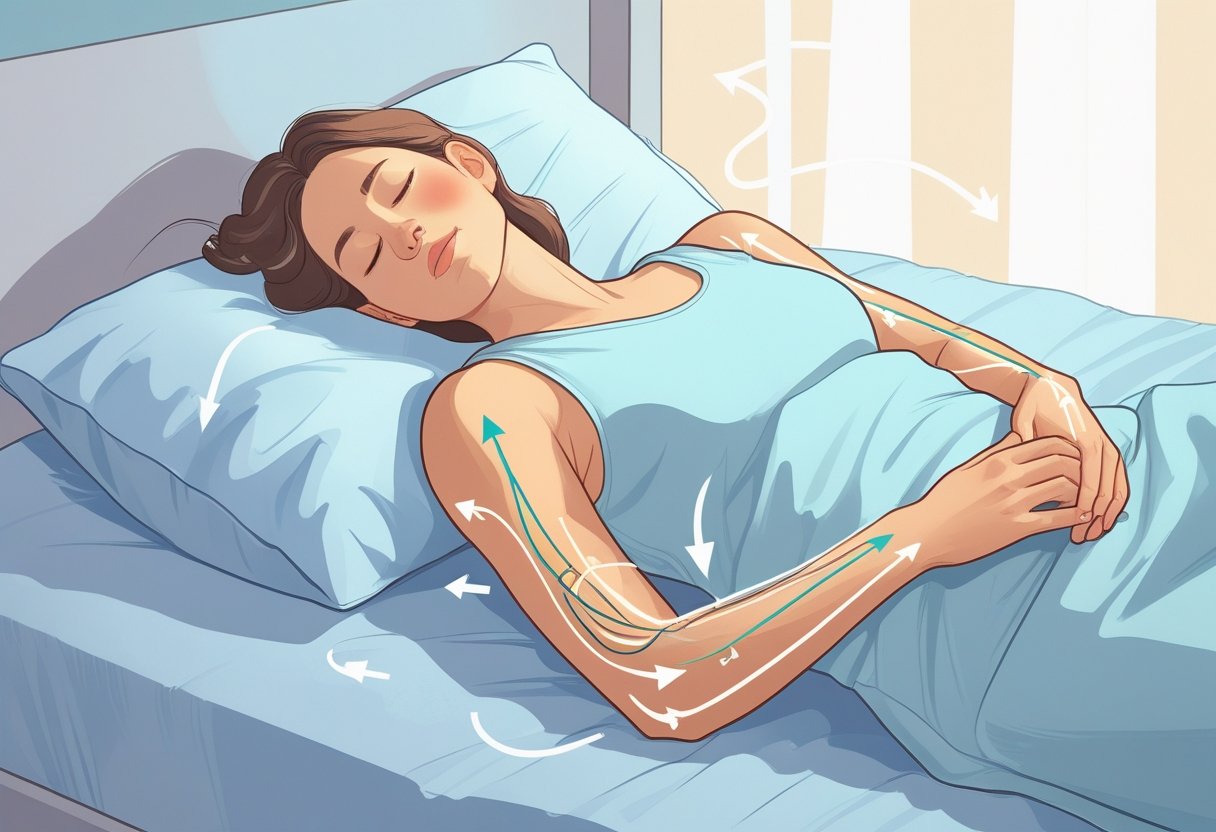
Why Circulation Matters During Sleep
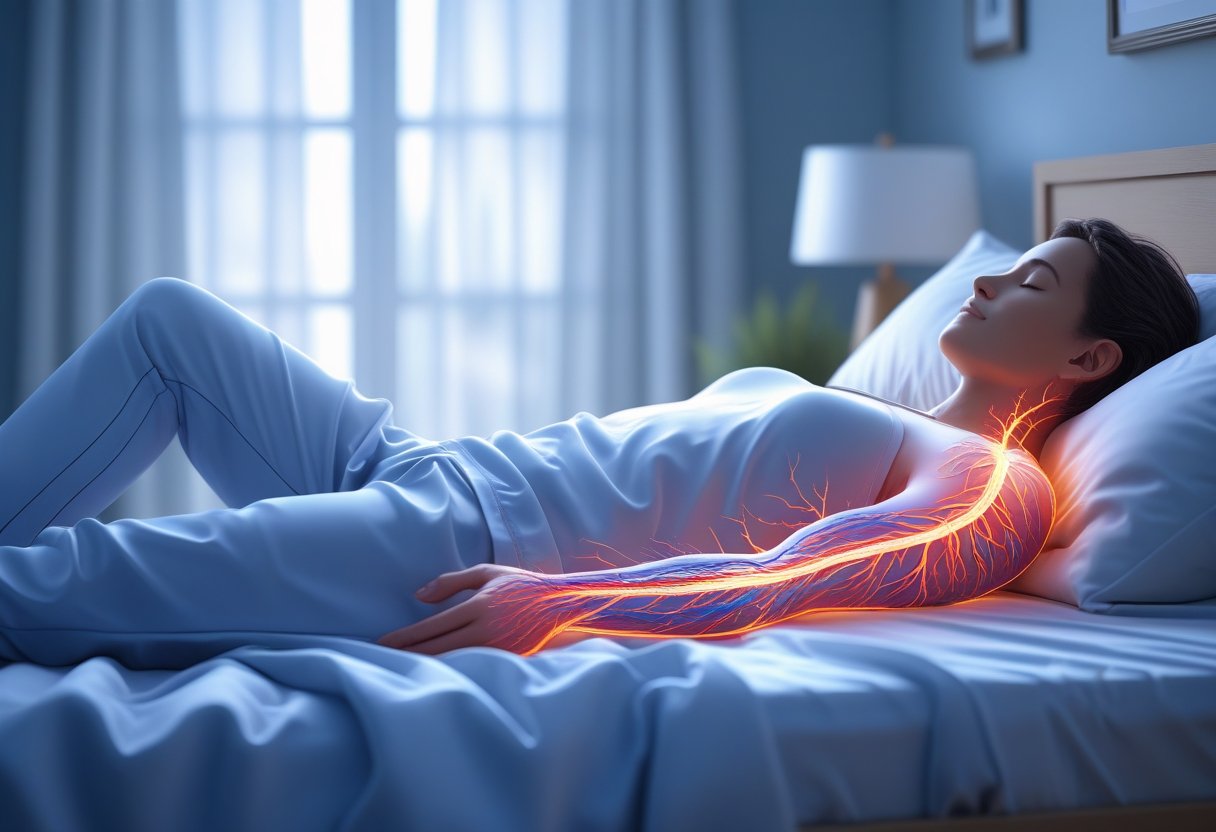
Good blood circulation during sleep proves essential for the body’s repair and maintenance. It delivers oxygen and nutrients to organs while removing waste products. Sleep positions influence how well blood flows, affecting overall health and comfort.
Functions of Healthy Blood Circulation
Healthy blood circulation moves oxygen-rich blood from the heart to every part of the body. It supports organs like the brain, kidneys, and muscles. At the same time, it carries away carbon dioxide and other waste. Circulation helps regulate body temperature and supports the immune system by moving infection-fighting cells. It also aids in healing damaged tissues and keeping energy levels steady.
Poor circulation can cause numbness, swelling, or cramps in the legs and feet. Left unchecked, it may lead to blood clots or vein problems.
How Sleep Affects Circulatory Health
During sleep, the body slows down and heart rate drops. The way someone sleeps can help or block blood flow.
For example, sleeping on the left side can reduce pressure on the heart and improve its efficiency. Sleeping on the back spreads weight evenly but may make breathing harder. Sleeping on the stomach can press on certain areas and slow blood flow. Raising the legs slightly helps blood return to the heart and reduces swelling. Using pillows to keep the spine aligned can prevent pressure points that disrupt circulation.
How Sleep Positions Impact Circulation
Sleep positions influence how blood moves through the body by altering gravity’s effect, the pressure on blood vessels, and the alignment of the spine and limbs. These factors determine comfort and circulation throughout the night.
Role of Gravity in Blood Flow at Night
When you lie down, gravity affects blood pressure differently than when you sit or stand. In a horizontal position, the heart works with less effort because blood does not need to move upward against gravity. Raising the legs during sleep helps blood return to the heart. Gravity eases pressure on the veins in the lower body, which can reduce swelling and improve circulation from the legs. Lying flat on your back can slow circulation in some cases, especially if you have vein or heart problems. Picking positions that use gravity wisely can help keep blood moving smoothly.
Effect of Pressure Points on Blood Vessels
Pressure points form where your body presses hard against the mattress. This pressure can squeeze blood vessels and reduce blood flow, leading to numbness, tingling, or the pins-and-needles feeling. Hips, heels, and shoulders are common spots for pressure buildup. Certain positions put more weight on these areas and can interfere with circulation, particularly for people who already have circulation issues.
Using pillows or shifting positions can lower pressure. Sleeping on your side spreads weight more evenly and avoids pressing directly on key blood vessels.
Influence of Spine and Limb Alignment
Keeping your spine and limbs in line helps circulation by preventing nerves and blood vessels from being compressed. Bad alignment can restrict blood flow or create tension that affects circulation.
Side sleeping with a pillow between the knees keeps the spine straight and eases strain on hips and legs. This position supports steady blood flow throughout the body. Stomach sleeping twists the neck and can limit blood flow to the head. Back sleeping spreads weight evenly but may not be ideal for people with sleep apnea or vein issues. Supporting the spine and adjusting limbs is important for maintaining healthy circulation.
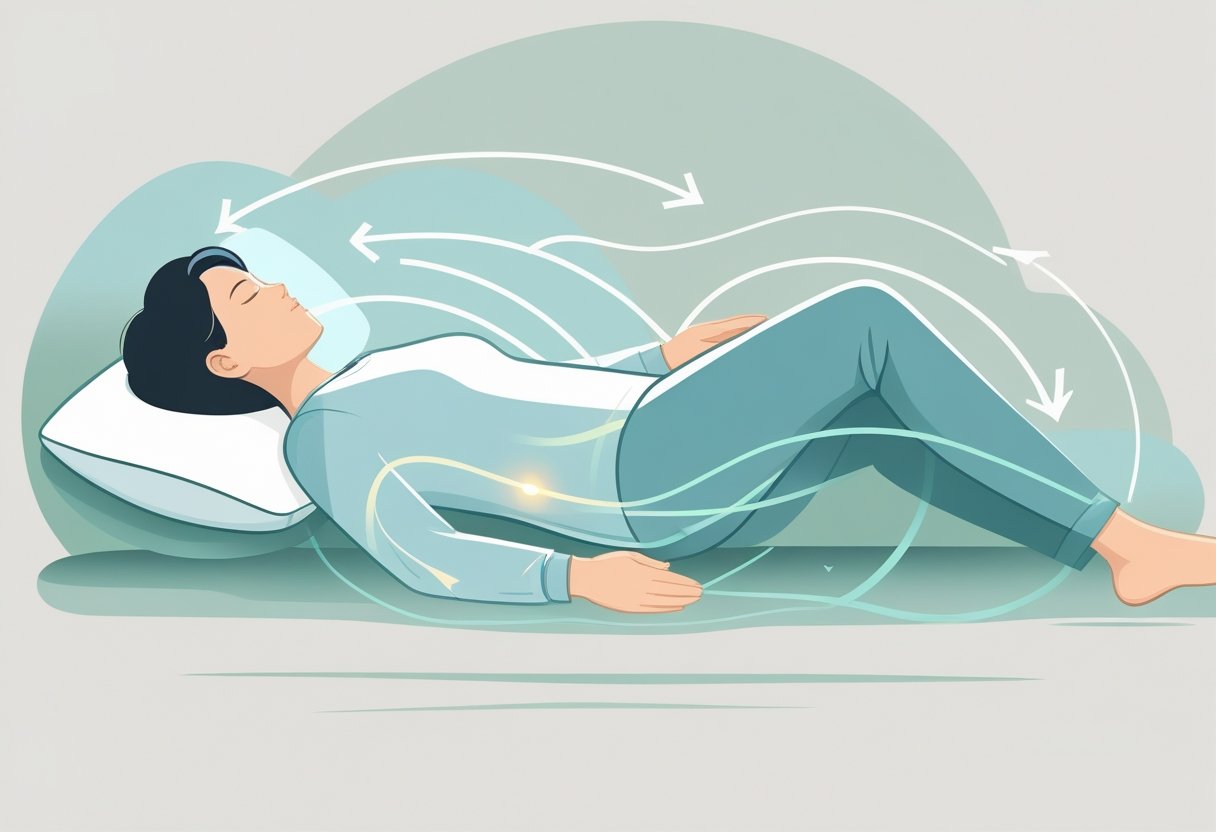
Best Sleep Positions for Optimized Circulation
Choosing the right sleep position improves blood flow, reduces pressure on blood vessels, and eases discomfort in the legs. Elevation and side preferences are important in circulation, especially for those with conditions like peripheral artery disease. These factors affect how blood travels from the legs back to the heart.
Sleeping on Your Back with Legs Elevated
Sleeping on your back with legs slightly raised can help blood flow. Gravity lowers pressure in the lower legs and eases discomfort from varicose veins or swelling. Blood returns to the heart more smoothly in this position.
You can elevate your legs with a wedge pillow or a few stacked pillows. Keep the angle gentle, around 15 to 30 degrees, so the lower back or hips don’t feel strained. This position supports circulation and can reduce swelling or discomfort from clots. It is one of the better sleeping positions for leg health and for people managing peripheral artery disease.
Left Side Versus Right Side Sleeping
Sleeping on your side also helps circulation, but the choice of side matters. Lying on the left side can help the heart pump more efficiently. It also reduces acid reflux because the stomach sits below the esophagus. People with heart problems sometimes choose the right side. This position lowers pressure on the heart and lungs and helps the lungs work better.
Both sides reduce pressure on areas that might restrict blood flow compared to sleeping on your back or stomach. Pick the side that feels comfortable and fits your health needs. Avoid crossing your legs, as this can block circulation no matter which side you sleep on.
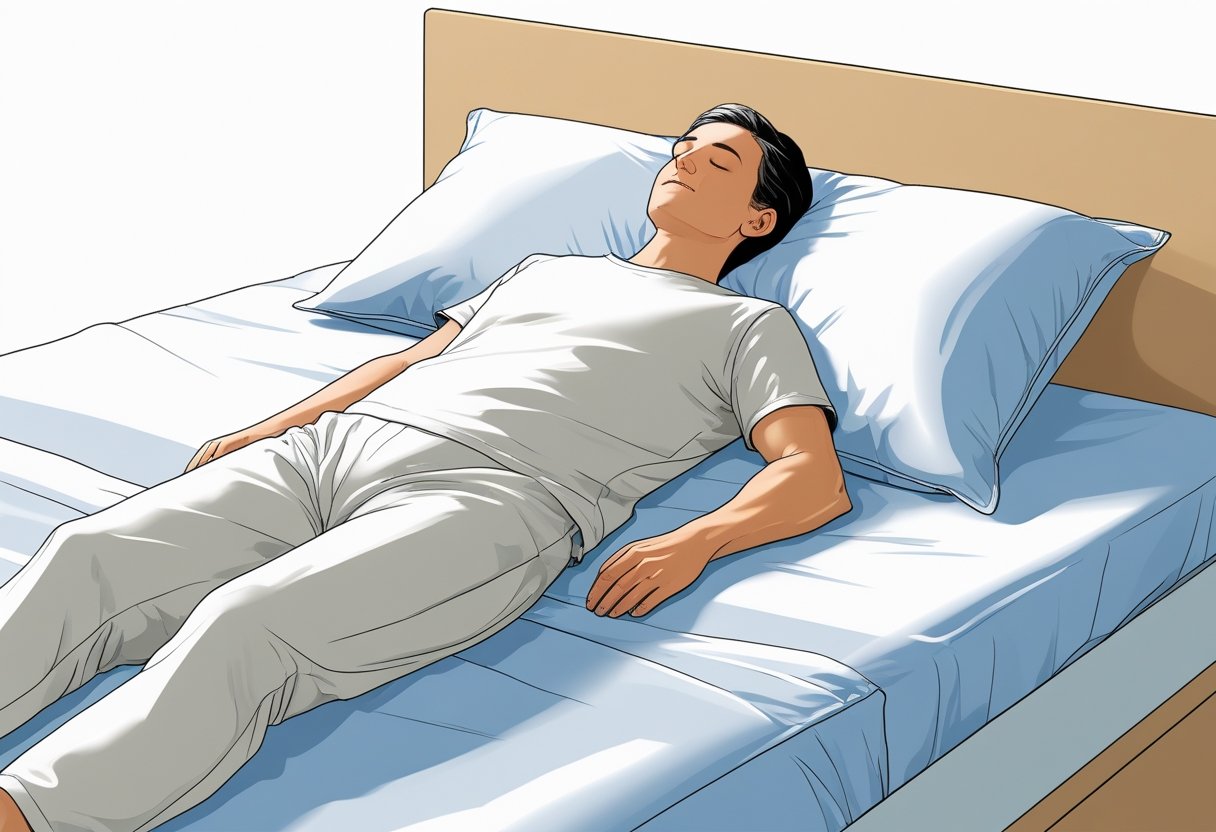
Special Sleep Positions for Health Conditions
Certain health conditions need specific sleep positions to help blood flow and ease symptoms. Changing how a person lies down can improve circulation in the legs and lower the chance of problems.
Semi-Fowler Position for Peripheral Artery Disease
The Semi-Fowler position raises the upper body between 15 and 45 degrees. People with peripheral artery disease (PAD) may feel relief in this position. It reduces pressure on the legs and helps blood move more easily through narrowed arteries. In this position, the legs can stay straight or slightly bent. That eases discomfort in the lower limbs. Raising the upper body also helps with breathing and reduces mucus in the sinuses, supporting better rest.
Adjustable beds or pillows can help set the right angle. Finding a comfortable position matters. Staying in this posture can ease symptoms linked to poor circulation in the legs.
Positions for Reducing Risk of Blood Clots
Sleeping in ways that avoid pressure on the legs can lower the chance of blood clots. Raising the legs slightly with a pillow lets gravity help move blood back to the heart. Side sleeping, particularly on the right side, can improve circulation and reduce strain on the veins. Crossing the legs should be avoided because it can block blood flow and increase clot risk.
Using a firm mattress and supportive pillows keeps the body aligned and prevents pressure points that slow circulation. Combining proper sleep posture with movement during the day supports healthy blood flow and lowers clot risk.
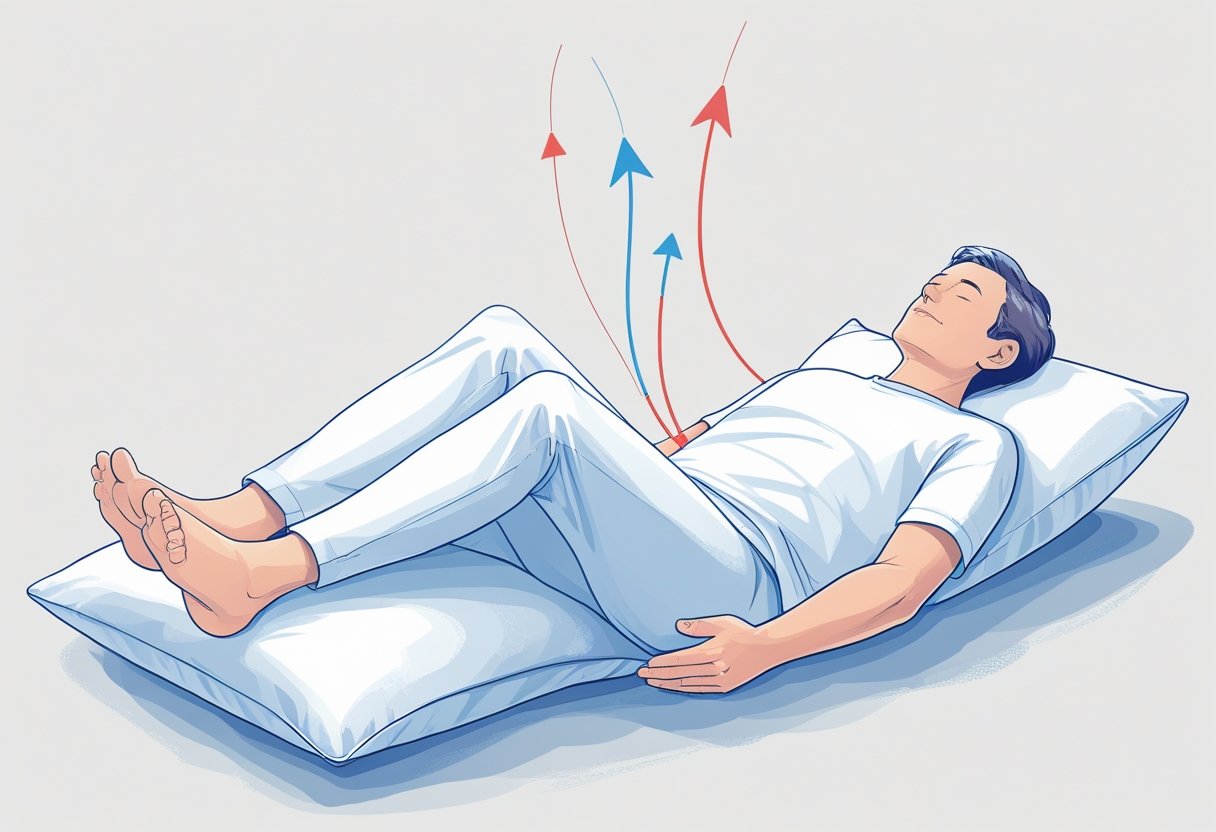
Sleep Positions to Avoid for Proper Circulation

Certain sleep positions limit blood flow and cause discomfort. Sleeping in the wrong position can lead to numbness, tingling, or make existing health issues worse. Changing how you sleep helps keep blood moving and eases pressure on your body.
Risks of Stomach Sleeping
Sleeping on your stomach puts weight on the chest and abdomen, which can affect heart and lung function. Turning your head to one side can pinch blood vessels in the neck. This position also stresses the spine and slows circulation in the neck and upper back. Nerves in the chest may get pressed, causing tingling or numbness. People with circulation problems usually notice more discomfort from sleeping this way, so it is better to avoid it.
Fetal Position and Circulation Concerns
Curling up tightly can press veins and arteries in the hips and knees, reducing blood flow to legs and arms. It can also pinch nerves, causing tingling or numbness.
Crossing your legs while curled adds extra pressure and can slow blood return from the lower legs. This may increase clot risk in those prone to circulation problems. A looser fetal position, with legs a bit extended, helps blood move more freely. Sleeping on your side with your body straight is the safest choice for circulation.
Tips and Sleep Accessories to Support Circulation
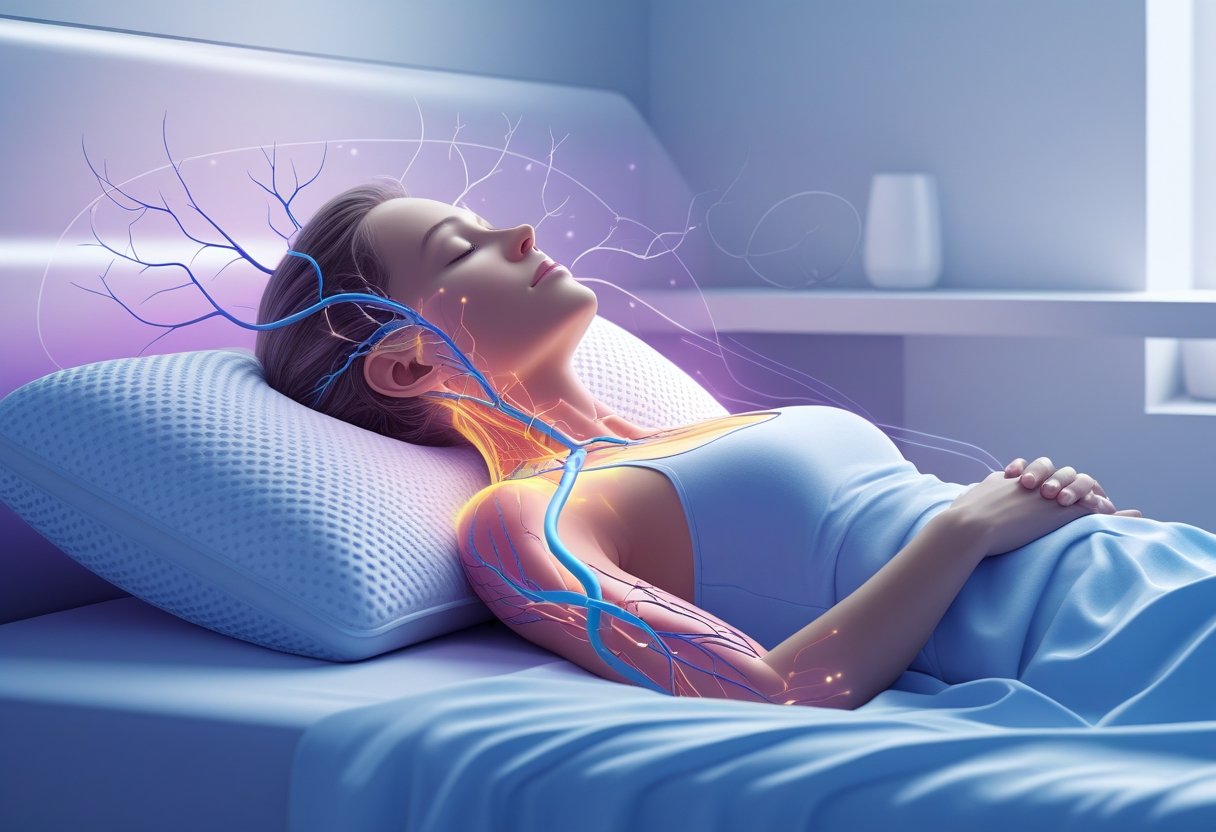
Proper support during sleep maintains good blood flow and reduces pressure on key areas. Small adjustments in bedding and position help comfort and prevent problems like numbness or swelling.
Choosing the Right Pillow and Mattress
A firm mattress that still feels comfortable keeps your body straight and lowers pressure points. Soft mattresses can make your body sink unevenly, which can pinch nerves and blood vessels. Memory foam or hybrid mattresses provide support without feeling too hard.
Pillows should hold the neck and head without tilting them forward. Side sleepers do better with a thicker pillow that fills the gap between the head and mattress. Back sleepers usually need a thinner pillow to keep the spine in line. Avoid pillows that push the head forward. Putting a pillow under the knees can help blood flow in the legs and reduce swelling.
Supporting Limb Alignment
Keeping legs and arms in the right position stops blood vessels from getting squeezed. Dangling feet off the bed edge can reduce circulation. It is better to keep feet supported with the mattress or pillows. Raising the legs slightly with a wedge or adjustable bed helps blood move back to the heart and can lower swelling, especially if you have circulation issues or varicose veins.
Crossing legs or bending joints for a long time can block blood flow. Moving and stretching gently while in bed supports healthy circulation. Soft braces or sleeves can help keep limbs in the right place without pressure.
Mattress Support and Sleep Positions for Better Circulation
A mattress serves as an important component in keeping the body supported in order to enhance circulation when sleeping. A mattress that is too soft or too firm can put pressure on blood vessels, which can slow blood flow in certain areas. Finding a balance in firmness helps the body stay supported. A medium-firm mattress usually provides even support. It helps keep the spine neutral and reduces pressure on areas like the hips and shoulders. This can make sleeping more comfortable and prevent aches that affect circulation.
A quality mattress combined with a good sleeping position can reduce discomfort and improve circulation at night. The Puffy Cloud Mattress has a medium-firm feel and cooling features, which can help create a more restful sleep.

Frequently Asked Questions
Different sleep positions change how blood moves through the body. Some positions reduce pressure on blood vessels. Others help the heart and lungs work better while you rest.







